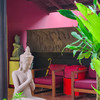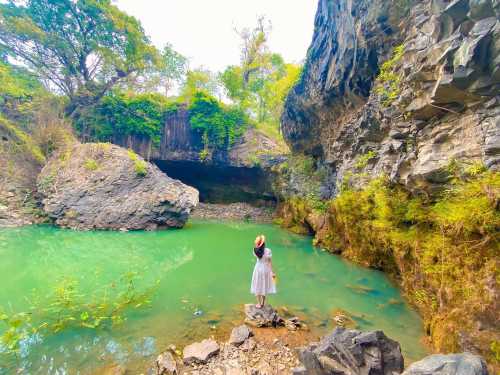Quan Thanh Temple: A Historical and Cultural Gem of Hanoi Overview Quan Thanh Temple (Đền Quán Thánh), also known as Tran Vu Temple, is one of Hanoi's oldest and most sacred Taoist temples. Established in the 11th century during the Ly Dynasty, it is part of the "Four Sacred Temples of Thang Long Citadel," guarding the northern entrance of the ancient capital. The temple is dedicated to Huyen Thien Tran Vu (Xuan Wu), the Taoist deity of the north, symbolized by a serpent and turtle. Located near West Lake at the intersection of Quan Thanh and Thanh Nien Streets, it remains a key spiritual and tourist site in Hanoi. Historical Significance - Founding: Built in 1010 under Emperor Ly Thai To to celebrate the relocation of Vietnam’s capital to Thang Long (modern Hanoi). - Sacred Role: One of four temples (alongside Bach Ma, Kim Lien, and Voi Phuc) positioned to protect the city from malevolent spirits and invaders. - Renovations: Restored multiple times, most notably in 1677 (when the iconic bronze statue was added) and 1893, blending Ly, Le, and Nguyen Dynasty architectural styles. Architecctural Highlights 1. Bronze Statue of Tran Vu: - Cast in 1677 by artisans from Ngũ Xã village, this 3.96-meter-tall, 3.6-ton black bronze statue depicts Tran Vu seated on a turtle, wielding a sword entwined by a serpent. It is Vietnam’s second-largest bronze statue and a masterpiece of 17th-century craftsmanship. - The deity’s symbols—the turtle (protection) and serpent (wealth)—reflect Taoist and Vietnamese folklore traditions. 2. Structural Features: - Three-Gate Entrance: Adorned with phoenixes and unicorns, typical of Nguyen Dynasty design. - Courtyard: Shaded by a centuries-old banyan tree, with a brick oven for burning joss paper during festivals. - Ancient Artifacts: Includes a 1.15-meter bronze bell, wood carvings of mythical creatures, and over 60 parallel poems in Chinese characters. Cultural and Spiritual Practices - Festivals: Locals visit during Tet (Lunar New Year) and on the 1st/15th lunar month days to pray for health, luck, and prosperity. - Syncretism: Though Taoist, the temple integrates Buddhist and Confucian elements, reflecting Vietnam’s religious blending. - Martial Arts: Hosts Vovinam classes, honoring Tran Vu’s association with martial prowess. Visitor Information - Location: 190 Quan Thanh Street, Ba Dinh District. - Hours: - Daily: 8:00 AM – 5:00 PM. - Extended hours on Tet Eve and lunar month days (6:00 AM – 8:00 PM). - Entry Fee: 10,000 VND (adults); 5,000 VND (students/children). - Dress Code: Modest attire covering shoulders and knees. Best Time to Visit: Early morning for tranquility, or during Tet (January–February) for vibrant rituals. Nearby Attractions 1. Tran Quoc Pagoda: Vietnam’s oldest pagoda, located on West Lake. 2. Ho Chi Minh Mausoleum: 1 km away, housing the embalmed leader. 3. Temple of Literature: Vietnam’s first university, dedicated to Confucius. Conclusion Quan Thanh Temple is a testament to Hanoi’s rich spiritual heritage and architectural ingenuity. Its iconic bronze statue, serene ambiance, and historical depth make it a must-visit for those exploring Vietnam’s cultural legacy. Whether admiring its artistry or participating in age-old rituals, the temple offers a profound glimpse into the soul of Hanoi. #travel #vietnam #hanoi #temple
Ice Lim 33
Popular Travel Types
Recommended Attractions at Popular Destinations
Bangkok attraction near me | Manila attraction near me | Tokyo attraction near me | Taipei attraction near me | Hong Kong attraction near me | Seoul attraction near me | Kuala Lumpur attraction near me | Los Angeles attraction near me | Shanghai attraction near me | New York attraction near me | Shenzhen attraction near me | Osaka attraction near me | Singapore attraction near me | London attraction near me | Guangzhou attraction near me | San Francisco attraction near me | Beijing attraction near me | Macau attraction near me | Bali attraction near me | Jakarta attraction near me | Paris attraction near me | Ho Chi Minh City attraction near me | Istanbul attraction near me | Phuket attraction near me | Chicago attraction near me | Seattle attraction near me | Toronto attraction near me | Orlando attraction near me | Cebu attraction near me | Chiang Mai attraction near me
Popular Ranked Lists
Top 3 Premium Hotels in Nakuru | Top 8 Best Things to Do in Chongzuo | Top 10 Local Restaurants in Tengchong | Popular Best Things to Do in Jishou | Popular Premium Hotels in Naypyidaw Union Territory | Top 4 Best Things to Do in Nanping | Top 7 Luxury Hotels in Taipei | Top 6 Best Things to Do in Ji'an | Popular Best Things to Do in Baiyin | Top 10 Local Restaurants in Xichang | Top 10 Local Restaurants in Dengfeng | Top 10 Local Restaurants in Kangding | Popular Best Things to Do in Yangquan | Top 6 Local Restaurants in Libo | Top 9 Local Restaurants in Pingyao | Top 3 Best Things to Do in Chizhou | Top 10 Local Restaurants in Zhaoqing | Top 7 Local Restaurants in Yuxi | Top 4 Premium Hotels in Paro | Top 3 Premium Hotels in Vila Real District | Top 10 Local Restaurants in Jinghong | Top 3 Best Things to Do in Linxia Prefecture | Popular Luxury Hotels in Genting Highlands | Top 17 Luxury Hotels in Taiwan | Popular Luxury Hotels in Paris | Popular Premium Hotels in South Backa District | Top 6 Best Things to Do in Hezhou | Popular Best Things to Do in Nanchong | Top 10 Local Restaurants in Shanwei | Popular Local Restaurants in Heze
Payment Methods
Our Partners
Copyright © 2025 Trip.com Travel Singapore Pte. Ltd. All rights reserved
Site Operator: Trip.com Travel Singapore Pte. Ltd.
Site Operator: Trip.com Travel Singapore Pte. Ltd.














